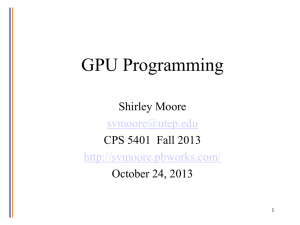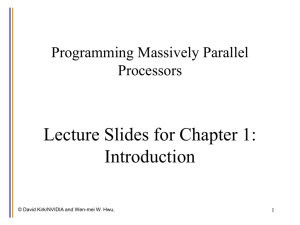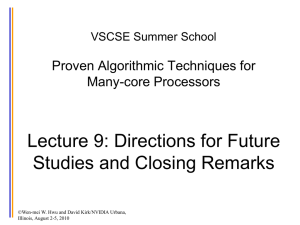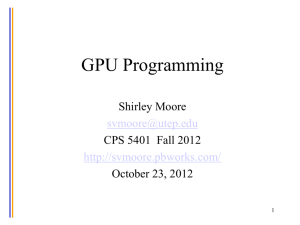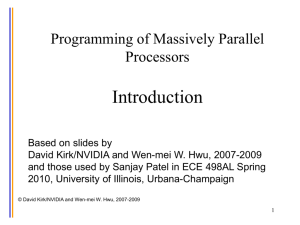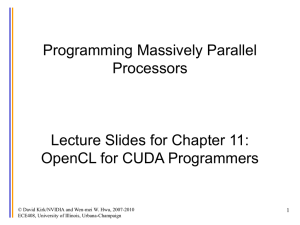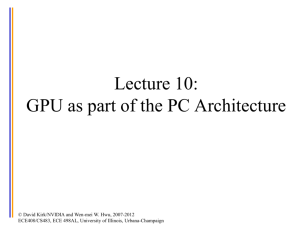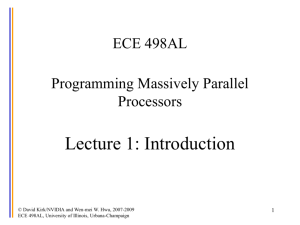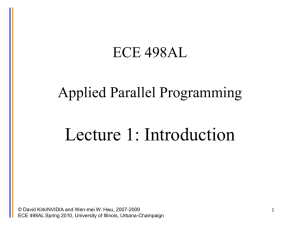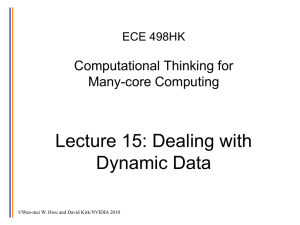Regular make
advertisement
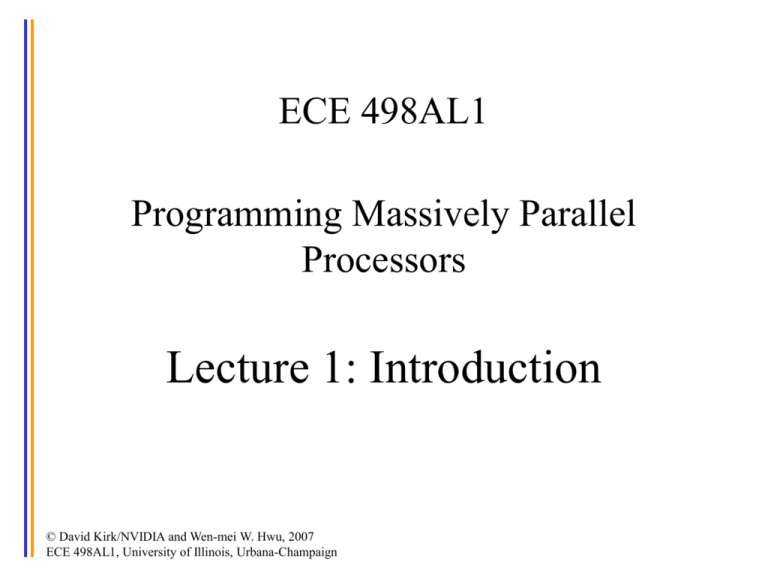
ECE 498AL1 Programming Massively Parallel Processors Lecture 1: Introduction © David Kirk/NVIDIA and Wen-mei W. Hwu, 2007 ECE 498AL1, University of Illinois, Urbana-Champaign Course Goals • Learn how to program massively parallel processors and achieve – high performance – functionality and maintainability – scalability across future generations • Acquire technical knowledge required to achieve the above goals – principles and patterns of parallel programming – processor architecture features and constraints – programming API, tools and techniques © David Kirk/NVIDIA and Wen-mei W. Hwu, 2007 ECE 498AL1, University of Illinois, Urbana-Champaign People • Professors: Wen-mei Hwu 215 CSL, w-hwu@uiuc.edu, 244-8270 use ECE498AL1 to start your e-mail subject line Office hours: 10-11:30am Tuesdays; or after class David Kirk Chief Scientist, NVIDIA and Professor of ECE • Teaching Assistants: ece498alTA@gmail.com John Stratton (stratton@uiuc.edu) Kwangwei Hwang (khwang3@uiuc.edu) Office hours: TBA © David Kirk/NVIDIA and Wen-mei W. Hwu, 2007 ECE 498AL1, University of Illinois, Urbana-Champaign Web Resources • Web site: http://courses.ece.uiuc.edu/ece498AL1 – Handouts and lecture slides/recordings – Documentation, software resoucres – Note: While we’ll make an effort to post announcements on the web, we can’t guarantee it, and won’t make any allowances for people who miss things in class. • Web board - coming soon – Channel for electronic announcements – Forum for Q&A - the TAs and Professors read the board, and your classmates often have answers • Compass - grades © David Kirk/NVIDIA and Wen-mei W. Hwu, 2007 ECE 498AL1, University of Illinois, Urbana-Champaign Grading This is a lab oriented course! • Test: 20% • Labs: 30% – Demo/knowledge: 25% – Functionality: 40% – Report: 35% • Project: 50% – Design Document: 25% – Project Presentation: 25% – Demo/Final Report: 50% © David Kirk/NVIDIA and Wen-mei W. Hwu, 2007 ECE 498AL1, University of Illinois, Urbana-Champaign Bonus Days • Each of you get five bonus days – A bonus day is a no-questions-asked one-day extension that can be used on most assignments – You can’t turn in multiple versions of a team assignment on different days; all of you must combine individual bonus days into one team bonus day. – You can use multiple bonus days on the same thing – Weekends/holidays don’t count for the number of days of extension (Friday-Monday is one day extension) • Intended to cover illnesses, interview visits, just needing more time, etc. © David Kirk/NVIDIA and Wen-mei W. Hwu, 2007 ECE 498AL1, University of Illinois, Urbana-Champaign Using Bonus Days • Web page has a bonus day form. Print it out, sign, and attach to the thing you’re turning in. – Everyone who’s using a bonus day on an team assignment needs to sign the form • Penalty for being late beyond bonus days is 10% of the possible points/day, again counting only weekdays (Fall break will count as weekdays) • Things you can’t use bonus days on: – Final project design documents, final project presentations, final project demo © David Kirk/NVIDIA and Wen-mei W. Hwu, 2007 ECE 498AL1, University of Illinois, Urbana-Champaign Academic Honesty • You are allowed and encouraged to discuss assignments with other students in the class. Getting verbal advice/help from people who’ve already taken the course is also fine. • Any reference to assignments from previous terms or web postings is unacceptable • Any copying of non-trivial code is unacceptable – Non-trivial = more than a line or so – Includes reading someone else’s code and then going off to write your own. © David Kirk/NVIDIA and Wen-mei W. Hwu, 2007 ECE 498AL1, University of Illinois, Urbana-Champaign Academic Honesty (cont.) • Giving/receiving help on a test is unacceptable • Penalties for academic dishonesty: – Zero on the assignment for the first occasion – Automatic failure of the course for repeat offenses © David Kirk/NVIDIA and Wen-mei W. Hwu, 2007 ECE 498AL1, University of Illinois, Urbana-Champaign Team Projects • Work can be divided up between team members in any way that works for you • However, each team member will demo the final checkpoint of each MP individually, and will get a separate demo grade – This will include questions on the entire design – Rationale: if you don’t know enough about the whole design to answer questions on it, you aren’t involved enough in the MP © David Kirk/NVIDIA and Wen-mei W. Hwu, 2007 ECE 498AL1, University of Illinois, Urbana-Champaign Lab Equipment • Location – Distributed (your own laptop/PC) first few weeks • Windows PCs running G80 emulators – Better debugging environment – Sufficient for first few weeks • NVIDIA G80 boards – Trusted Illiac Prototype Server accounts – Much much faster but less debugging support © David Kirk/NVIDIA and Wen-mei W. Hwu, 2007 ECE 498AL1, University of Illinois, Urbana-Champaign Text/Notes 1. NVIDIA, NVidia CUDA Programming Guide, NVidia, 2007 2. M. Pharr (ed.), GPU Gems 2 – Programming Techniques for High Performance Graphics and General-Purpose Computation, Addison Wesley, 2005 (recomm.) 3. T. Mattson, et al “Patterns for Parallel Programming,” Addison Wesley, 2005 (recomm.) 4. Lecture notes by Prof. Hwu and Prof. Kirk will be posted at the class web site © David Kirk/NVIDIA and Wen-mei W. Hwu, 2007 ECE 498AL1, University of Illinois, Urbana-Champaign Tentative Schedule/Make-up Classes • Regular make-up classes – Tuesdays, 5:10-6:30 during selected weeks, location 141 CSL • Week 1: – Wed, 8/22 : Lecture 1: Introduction – MP-0, installation, run hello world • Week 2: • Week 3: DK in IL – Tue, 9/4 (makeup) : Lecture 4 CUDA memory model, tiling – Wed, 9/5 (makeup) : Lecture 5 – GPU History – MP-2, tiled matrix multiplication • Week 4 – Tue, 8/28 (makeup): Lecture 2 – GPU Computing and CUDA Intro – Mon, 9/10: Lecture 6 – CUDA Hardware – Wed, 8/29 : Lecture 3 – GPU Computing and CUDA Intro – Tue, 9/11 : Lecture 7 – GPU Compute Core – MP-1, simple matrix multiplication and simple vector reduction – Wed, 9/12, Lecture 8 – GPU Compute Core © David Kirk/NVIDIA and Wen-mei W. Hwu, 2007 ECE 498AL1, University of Illinois, Urbana-Champaign – MP-3, simple and tiled 2D convolution ECE498AL Development History Kirk gives guest lecture at Hwu’s class. Blahut challenges Kirk and Hwu 1/06 … NVIDIA announces G80, Hwu/students training at NVIDIA 11/06 Kirk visits UIUC, picking UIUC over others © David Kirk/NVIDIA and Wen-mei W. Hwu, 2007 ECE 498AL1, University of Illinois, Urbana-Champaign 1/07 NVIDIA releases CUDA, UIUC lecture and lab material went online, G80 cards 2/07 Kirk and Hwu in panic mode cooking up course material 3/07 NAMD and other apps group report results and post projects Why Massively Parallel Processor • A quiet revolution and potential build-up Calculation: 367 GFLOPS vs. 32 GFLOPS Memory Bandwidth: 86.4 GB/s vs. 8.4 GB/s Until last year, programmed through graphics API GFLOPS – – – G80 = GeForce 8800 GTX G71 = GeForce 7900 GTX G70 = GeForce 7800 GTX NV40 = GeForce 6800 Ultra NV35 = GeForce FX 5950 Ultra NV30 = GeForce FX 5800 – GPU in every PC and workstation – massive volume and potential impact © David Kirk/NVIDIA and Wen-mei W. Hwu, 2007 ECE 498AL1, University of Illinois, Urbana-Champaign GeForce 8800 16 highly threaded SM’s, >128 FPU’s, 367 GFLOPS, 768 MB DRAM, 86.4 GB/S Mem BW, 4GB/S BW to CPU Host Input Assembler Thread Execution Manager Parallel Data Cache Parallel Data Cache Parallel Data Cache Parallel Data Cache Parallel Data Cache Parallel Data Cache Parallel Data Cache Parallel Data Cache Texture Texture Texture Texture Texture Texture Texture Texture Texture Load/store Load/store Load/store Load/store © David Kirk/NVIDIA and Wen-mei W. Hwu, 2007 Global Memory ECE 498AL1, University of Illinois, Urbana-Champaign Load/store Load/store G80 Characteristics • 367 GFLOPS peak performance (25-50 times of current high-end microprocessors) • 265 GFLOPS sustained for apps such as VMD • Massively parallel, 128 cores, 90W • Massively threaded, sustains 1000s of threads per app • 30-100 times speedup over high-end microprocessors on scientific and media applications: medical imaging, molecular dynamics “I think they're right on the money, but the huge performance differential (currently 3 GPUs ~= 300 SGI Altix Itanium2s) will invite close scrutiny so I have to be careful what I say publically until I triple check those numbers.” -John Stone, VMD group, Physics UIUC © David Kirk/NVIDIA and Wen-mei W. Hwu, 2007 ECE 498AL1, University of Illinois, Urbana-Champaign Future Apps Reflect a Concurrent World • Exciting applications in future mass computing market have been traditionally considered “supercomputing applications” – Molecular dynamics simulation, Video and audio coding and manipulation, 3D imaging and visualization, Consumer game physics, and virtual reality products – These “Super-apps” represent and model physical, concurrent world • Various granularities of parallelism exist, but… – programming model must not hinder parallel implementation – data delivery needs careful management © David Kirk/NVIDIA and Wen-mei W. Hwu, 2007 ECE 498AL1, University of Illinois, Urbana-Champaign Stretching Traditional Architectures • Traditional parallel architectures cover some super-applications – DSP, GPU, network apps, Scientific • The game is to grow mainstream architectures “out” or domain-specific architectures “in” – CUDA is latter Traditional applications Current architecture coverage New applications Domain-specific architecture coverage © David Kirk/NVIDIA and Wen-mei W. Hwu, 2007 ECE 498AL1, University of Illinois, Urbana-Champaign Obstacles Previous Projects Application Description SPEC ‘06 version, change in guess vector H.264 Source 34,811 Kernel % time 194 35% LBM SPEC ‘06 version, change to single precision and print fewer reports 1,481 285 >99% RC5-72 Distributed.net RC5-72 challenge client code 1,979 218 >99% FEM Finite element modeling, simulation of 3D graded materials 1,874 146 99% RPES Rye Polynomial Equation Solver, quantum chem, 2-electron repulsion 1,104 281 99% PNS Petri Net simulation of a distributed system 322 160 >99% SAXPY Single-precision implementation of saxpy, used in Linpack’s Gaussian elim. routine 952 31 >99% TRACF Two Point Angular Correlation Function 536 98 96% FDTD Finite-Difference Time Domain analysis of 2D electromagnetic wave propagation 1,365 93 16% 490 33 >99% Computing a matrix Q, a scanner’s MRI-Q © David Kirk/NVIDIA configuration and Wen-mei W.inHwu, MRI2007 reconstruction ECE 498AL1, University of Illinois, Urbana-Champaign Speedup of Applications 457 316 431 263 210 79 GPU Speedup Relative to CPU 60 50 40 Ke rn e l Ap p lic a tio n 30 20 10 0 H .2 6 4 LBM R C 5 -7 2 F EM R PES PN S SA XPY T PA C F FDTD M R I-Q M R IFHD • GeForce 8800 GTX vs. 2.2GHz Opteron 248 • 10 speedup in a kernel is typical, as long as the kernel can occupy enough parallel threads • 25 to 400 speedup if the function’s data requirements and control flow suit the GPU and the application is optimized • Keep in mind that the speedup also reflects how suitable the CPU is for executing the kernel © David Kirk/NVIDIA and Wen-mei W. Hwu, 2007 ECE 498AL1, University of Illinois, Urbana-Champaign
